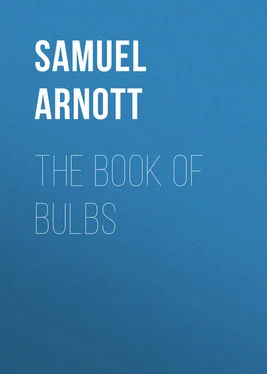Samuel Arnott - The Book of Bulbs
Здесь есть возможность читать онлайн «Samuel Arnott - The Book of Bulbs» — ознакомительный отрывок электронной книги совершенно бесплатно, а после прочтения отрывка купить полную версию. В некоторых случаях можно слушать аудио, скачать через торрент в формате fb2 и присутствует краткое содержание. Жанр: foreign_antique, foreign_prose, на английском языке. Описание произведения, (предисловие) а так же отзывы посетителей доступны на портале библиотеки ЛибКат.
- Название:The Book of Bulbs
- Автор:
- Жанр:
- Год:неизвестен
- ISBN:нет данных
- Рейтинг книги:5 / 5. Голосов: 1
-
Избранное:Добавить в избранное
- Отзывы:
-
Ваша оценка:
- 100
- 1
- 2
- 3
- 4
- 5
The Book of Bulbs: краткое содержание, описание и аннотация
Предлагаем к чтению аннотацию, описание, краткое содержание или предисловие (зависит от того, что написал сам автор книги «The Book of Bulbs»). Если вы не нашли необходимую информацию о книге — напишите в комментариях, мы постараемся отыскать её.
The Book of Bulbs — читать онлайн ознакомительный отрывок
Ниже представлен текст книги, разбитый по страницам. Система сохранения места последней прочитанной страницы, позволяет с удобством читать онлайн бесплатно книгу «The Book of Bulbs», без необходимости каждый раз заново искать на чём Вы остановились. Поставьте закладку, и сможете в любой момент перейти на страницу, на которой закончили чтение.
Интервал:
Закладка:
CHAPTER II
HARDY BULBS
Although the effective Aconitums or Monkshoods of our gardens are usually classed with ordinary herbaceous plants, the best of those with tuberous roots can hardly be omitted from this work. They are of much service in the mixed border or the wild garden, and it is only the poisonous properties of these plants which make one view them with suspicion. They should not be planted where any danger can result to children or to animals. Their nomenclature is very confused but the names below are authoritative. The following are some of the best: – Cammarum, four feet, purple; flaccidum, six feet, violet; heterophyllum, two feet, yellow and blue; japonicum, six feet, flesh; Lycoctonum, a pretty yellow species, four to six feet high; Napellus, very poisonous, in several varieties, four to six feet; paniculatum, three feet; and variegatum, three to six feet, blue, white, or blue and white. All of these grow in any soil and can be planted in spring or autumn.
The Alliums can hardly be classed as among the choicest of bulbous plants; but although not among the élite of our garden flowers, there are, however, among them some pleasing and useful flowers, and a few remarks upon some of those most easily obtainable may be of service. It may be premised that the Alliums are most suitable for naturalising in grass or in wild gardens, as many of them are so prolific that they are apt to become troublesome in the border. They usually seed very freely and some produce offsets in great numbers, while others, again, form little bulbils on their heads which eventually form separate individuals. Almost all are of easy cultivation, although some of the Central Asian and Californian species need a little protection in winter.
A. acuminatum is a pretty dwarf species with deep rose flowers, and other pretty dwarf forms or species of similar or deeper colour are Bidwilliæ, Breweri, falcifolium, Fetisowii, macnabianum, narcissiflorum, ostrowskianum, and pedemontanum. A few blue species exist and are generally very pretty, though sometimes tender; of these, cæruleum, cyaneum, kansuense, and violaceum may be mentioned. A great many have white flowers and it is among these that we find the most valued of the species. The greatest favourite is neapolitanum, so much used for forcing, and which is grown in pots under the same treatment as other bulbous plants. Other pretty white species are triquetrum, subvillosum, Erdelii, and falciforme. None of the yellow species are equal to the old A. Moly, a bright June flower, but others of worth in their own way are flavum, and the straw-coloured stramineum. Good tall species, some having ornamental foliage, are karataviense, giganteum, sphærocephalum, nigrum, Suworowi, and nobile. The great drawback of the Alliums is their odour, which is, however, not always perceptible except when the flowers are cut.
There are few finer or more useful garden flowers than the Alstrœmerias, whose brilliant colours and uncommon forms are great attractions. As cut flowers they are highly prized. They like a free root run, and a rather light, rich soil. The tubers should be planted in spring, nearly a foot deep, but they are easily raised from seeds sown in gentle heat in spring. Several of the species are too tender for outdoor cultivation everywhere, the hardiest being A. aurantiaca, which has yellow flowers of varying shades. Chilensis and peruviana, or versicolor, and psittacina of gardens (syn. pulchella), are all fairly hardy, psittacina possessing a singular combination of crimson and green colouring. A. pelegrina and its variety alba are exceedingly beautiful, but require frame treatment except in the south. Diazii, Ligtu, and hæmantha (syn. Simsii) are very beautiful and more or less hardy according to the climate and soil. Some lime rubbish is often useful mixed with the soil, together with a little peat or leaf-mould.
The tuberous-rooted Anemones, which alone come under the scope of this work, form a section which embraces flowers of surpassing beauty. Generally dwarf in stature, these Windflowers give us much variety of colouring, from the pure white of A. nemorosa to the deep scarlet of A. fulgens, with the blues, purples, and other tints of A. coronaria, and the bright yellow of A. ranunculoides. Usually of easy cultivation, they are among the choicest ornaments of our gardens.
A. apennina, the Apennine Windflower, is a delightful little plant, growing about six inches high and having pretty blue flowers. There are white and rose-coloured varieties. It likes a peaty soil, and prefers shade. It is a charming plant to naturalise in the woods, where it flowers in March and April.
A. baldensis, the Mount Baldo Windflower, is of erect but dwarf habit, and grows about six inches high. It has little white flowers tinged with blue or red, and does well on a rockery in half-shade in sand and peat.
A. blanda, the Fair, or Greek Windflower, is one of the earliest of our flowers in sunny gardens, and frequently opens soon after New Year's Day. It needs a well-drained, warm position, but flowers better on a stiffish soil.
There are several forms of this very beautiful Windflower. That called cypriana has flowers which vary from white to lilac and pale blue, and the variety taurica has blooms which embrace an even deeper blue among its shades. The variety scythinica is one of the choicest. The exterior of the flower is blue, while the inside is pure white. The seeds of A. blanda should be sown as soon as ripe.
A. caroliniana, a North American Anemone, now referred to heterophylla, grows about nine inches high, and has finely cut leaves and white or purplish flowers in May. It likes a shady place and peaty soil.
A. coronaria is the well-known Poppy or Crown Anemone, which is so wonderfully varied in its form and colouring. We have no more effective flower than this in beds or lines in May. For cutting, its blooms are most useful. This Anemone is best propagated from seed annually. It likes a rich, light soil, and cow manure is the best to apply to it. The "St Brigid" strain is a charming one, and the flowers it produces are of great beauty. Tubers of A. coronaria of excellent quality can be purchased at a very low price, and should be planted in a sunny position about three inches deep in October or November. Seeds should be sown in March or April, and should be mixed with dry soil or sand to separate them. The double Crown Anemones are very beautiful, although not so much grown as when they were favourite florists' flowers. They are of almost every colour but yellow. A good white is named "The Bride."
A. fischeriana, a Siberian plant, grows about six inches high, and has white flowers. A. intermedia is a new Anemone with yellowish flowers, and seems allied to nemorosa.
A. nemorosa, our native Windflower, gives us several lovely forms. The double form, A. n. flore-pleno, is very beautiful, and there are a few large-flowered forms, besides the pretty bracteata, which has ruff-like green bracts round the flower. The variety rosea and its double form have rosy flowers, and cærulea has pretty blue blooms, but is surpassed by the charming robinsoniana of a brighter blue. Alleni is even larger and better coloured than the last-named. All these like shade and peaty soil.
A. palmata is a lovely little plant, which grows from six to nine inches high, and has yellow flowers. There is a white variety, and a very rare double one. It likes a moist, peaty soil.
A. ranunculoides is a pretty little native species of the nemorosa type, but with smaller yellow flowers. The variety pallida, with pale yellow blooms, is very pretty.
Читать дальшеИнтервал:
Закладка:
Похожие книги на «The Book of Bulbs»
Представляем Вашему вниманию похожие книги на «The Book of Bulbs» списком для выбора. Мы отобрали схожую по названию и смыслу литературу в надежде предоставить читателям больше вариантов отыскать новые, интересные, ещё непрочитанные произведения.
Обсуждение, отзывы о книге «The Book of Bulbs» и просто собственные мнения читателей. Оставьте ваши комментарии, напишите, что Вы думаете о произведении, его смысле или главных героях. Укажите что конкретно понравилось, а что нет, и почему Вы так считаете.












